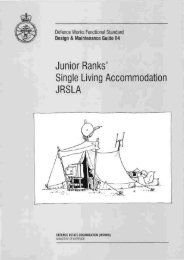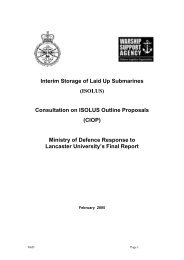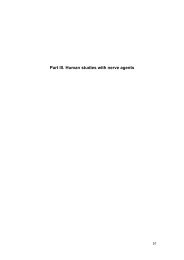Specification 49 Stone Mastic Asphalt for Airfields - Ministry of Defence
Specification 49 Stone Mastic Asphalt for Airfields - Ministry of Defence
Specification 49 Stone Mastic Asphalt for Airfields - Ministry of Defence
You also want an ePaper? Increase the reach of your titles
YUMPU automatically turns print PDFs into web optimized ePapers that Google loves.
<strong>Specification</strong> <strong>49</strong> <strong>Stone</strong> <strong>Mastic</strong> <strong>Asphalt</strong> <strong>for</strong> <strong>Airfields</strong> 6 Plant and Workmanship<br />
6 Plant and Workmanship<br />
6.1 REDUCTION IN SURFACE LEVEL OF<br />
ASPHALT SURFACES<br />
Where the surface level <strong>of</strong> an existing asphalt<br />
surface is being reduced, thicknesses shall be<br />
removed with a planing machine that has been<br />
approved by the Project Manager. The machine<br />
shall be provided with control devices that enable<br />
the rapid adjustment <strong>of</strong> blades to fine depth-<strong>of</strong>-cut<br />
settings while the machine is operating.<br />
6.2 REDUCTION IN SURFACE LEVEL OF<br />
CONCRETE SURFACES<br />
6.2.1 Where the surface level <strong>of</strong> an existing<br />
concrete surface is being reduced, thicknesses from<br />
fine fractions up to the limits as specified hereafter<br />
shall be removed by scabbling or planing.<br />
Scabbling or planing shall be carried out by<br />
machines operated in a manner that results in a<br />
minimum <strong>of</strong> over-cutting and uni<strong>for</strong>m exposure <strong>of</strong><br />
the aggregate, without shattering or otherwise<br />
damaging the concrete slabs.<br />
6.2.2 Unless directed by the Project Manager,<br />
such reductions in level shall be bounded by joints<br />
in the concrete pavement. Where they are not and<br />
where the scabbling or planing is not tapered to<br />
zero depth, the area to be reduced in level shall first<br />
be defined by saw cuts, 5 mm deeper than the<br />
depth <strong>of</strong> the scabbling or planing.<br />
6.2.3 The surface treated as above shall be<br />
thoroughly cleaned with hand brooms and all loose<br />
debris shall be collected and removed.<br />
6.2.4 Be<strong>for</strong>e the area is surfaced, a tack or bond<br />
coat appropriate to the surfacing material shall be<br />
applied as specified in Clause 6.10 and the<br />
exposed vertical edges shall be painted with hot<br />
bitumen. The new surfacing shall be made to firmly<br />
adhere to the vertical edges.<br />
6.2.5 The whole <strong>of</strong> the concrete layer shall be<br />
removed <strong>for</strong> its full depth where the thickness<br />
required to be removed is greater than the lesser <strong>of</strong>:<br />
• 100 mm; and<br />
• one third the depth <strong>of</strong> the slab.<br />
Where the concrete is in bays less than 4.5 m<br />
square, the boundary <strong>of</strong> the area to be removed<br />
shall be defined by bay joints. Where the bays are<br />
larger, part bays may be removed such that the<br />
remaining portion shall not be less than 2.25 m by<br />
the full length or full width <strong>of</strong> the bay.<br />
6.2.6 Care shall be taken to ensure that all<br />
concrete remaining in the vicinity <strong>of</strong> cutting-out<br />
remains sound and without fracture and that<br />
disturbance to sub-bases and underlying layers is<br />
minimised.<br />
6.3 PREPARATION OF EXISTING<br />
ASPHALT SURFACES<br />
6.3.1 Be<strong>for</strong>e the tack or bond coat is applied, all<br />
vegetable growth and loose aggregate or other<br />
particles shall be removed from all cracks in the<br />
existing asphalt surfacing on which new surfacing is<br />
to be laid. Loose laitance and other spalling or<br />
debonded slurry seal shall be removed from the<br />
surface. The surfaces shall be swept until standing<br />
water, mud, grit and all other extraneous matter has<br />
been removed. Immediately ahead <strong>of</strong> tack or bond<br />
coating, all dust shall be removed by vacuum<br />
extraction cleaning, with or without high-pressure<br />
water at the discretion <strong>of</strong> the Project Manager.<br />
(NOTE 1. Cleaning machines applying high-pressure<br />
water and vacuum extraction are very effective in<br />
removing debris and cleaning the surface. Water<br />
pressures about 50 Bar are adequate <strong>for</strong> general<br />
cleaning, but higher pressures may be used subject to the<br />
Project Manager’s discretion. At very high pressures,<br />
damage to the surfacing can result.)<br />
(NOTE 2. Vacuum extraction after high pressure<br />
cleaning generally results in a sufficiently dry surface <strong>for</strong><br />
application <strong>of</strong> a tack or bond coat.)<br />
6.3.2 Existing overbanding <strong>of</strong> the surfacing shall<br />
be removed when required by the Project Manager.<br />
(NOTE. When resurfacing comprises only a surface<br />
course, it will normally be a requirement to at least<br />
remove thick depositions <strong>of</strong> overbanding.)<br />
July 2008 13









